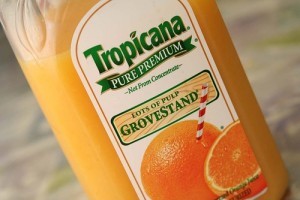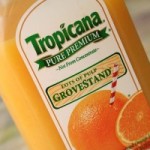
After working with thousands of families, one of the big questions I am asked is about juice. Fresh or processed? How does processed juice stack up to fresh?
The basic chef’s take on juices are that if they tastes good then use them.
However, the question being asked is “Which is better, fresh juice or processed juice?” and my professional opinion parents want to know about the unknown processes that go into making processed juice. Also is the processed juice still a healthier choice option?
I am a fan of fresh juices. Each year in America, as more cultures move closer together, the grocery stores need to satisfy an ever sophisticated community by carrying more kinds of merchandise to satisfy the community they serve.
Fresh is always the first thing grocery store suppliers look into. They check local sources, prices, regional manufacturers, etc. Next the grocery markets look to frozen, canned and then processed styled items. The most profit for the stores is with processed foods.
Processing juices have lots of science built into them. So the products made have a longer shelf-life. This gives stores a longer time to sell them and make more money. My research finds that when juice is processed the original nutritional value and other healthful benefits of the juice get removed.
There are billions of dollars and many companies involved in trying to make good juice products. I still prefer fresh.
Here are some of the processes I found from my online research and speaking with many people:
HPP – hiperbaric method of juice and smoothie preservation. Imagine using a High Pressure Process that is non-thermal and environmentally friendly to preserve the shelf-life of a processed product. This is interesting since it uses a high amount of oxygen. This sounds like going to the hospital and breathing through an oxygen mask. Or something Michael Jackson would do. Check out www.hiperbaric.com/en/juices for more information.
HPP changes juices by “neutralizing the benefits of the live enzymes, probiotics, vitamins, proteins, and nutrients that would otherwise be retained in raw and unpasteurized juice.”
HPP treated juice can last up to 45 days which is nine times longer than a freshly made cold-pressed juice.
A Professor of the Food Science and Technology Department at Ohio State University explained that HPP doesn’t damage the product and that HPP is effective in retaining the nutrients, flavor or texture of a product. Another Professor of Food Science at University of Delaware agrees that “it really doesn’t break bonds or compounds as this professor noted that antioxidants and vitamin C will not be significantly reduced.
HPP has been used in the US since the mid-90s. Juice companies have learned how to harness HPP for their own products only for the past ten years. This HPP is relatively a new and unknown process to most consumers.
Most consumers only know label descriptions such as “Raw”, “100% Natural”, or “Contains 100% Juice”. But these don’t tell you if you are getting a fresh or processed product. Its just not enough and as you probably already know, juice companies really don’t want you knowing too much about their business.
At the time of this writing:
“Raw” is used or referred to as unpasteurized cold-pressed fruit that has a shelf life of 2-3 days, or HPP treated cold-pressed juice with a shelf life of up to 45 days.
“Contains 100% Juice” is used or referred to as everything in the bottle came from fruit or vegetables and may not be the fruits or vegetables shown on the packaging. For example, cranberry juice may be 100% juice and is diluted with apple or pear juice. this is still considered “100% juice”.
“Unpasteurized” is gaining popularity in the US. this would include items such as fresh-squeezed apple cider at a local orchard or New York City based bars like Juice Press or Liquiteria. These juices have a shelf life of 2-3 days and are generally 3 times more expensive than what kids have in their lunchbox.
“Pasteurized” refers to the use of thermal (heat) in order to kill harmful pathogens, like E.coli. Juice products are subject to heat.
“Flash pasteurization” which supposedly maintains the color and flavor of a product.
“From Concentrate” is the most commonly used by juice companies. In this process, the juice product has been  pasteurized which extracts water and creates a “concentrated” juice product. The consumer adds water to dilute the concentrated juice before serving, thus reconstituting the juice.
pasteurized which extracts water and creates a “concentrated” juice product. The consumer adds water to dilute the concentrated juice before serving, thus reconstituting the juice.
Concentrated items seem like a yo-yo to me. Why reduce a product then add water again? Just use fresh. Its faster, more nutrient rich, natural, retains the original cellular and phytonutrient structures and tastes great.
“Not From Concentrate” is also very common such as Tropicana and Florida’s Natural which have been around since before the 1980s.
From Concentrate” is also very common such as Tropicana and Florida’s Natural which have been around since before the 1980s.
Here no water has been removed from the product. The product may be stripped of oxygen when out of season. Juice companies add flavor packs after the oxygen stripping process to bring the taste up during out-of-season production. The FDA does not currently require juice companies to list flavor packs on a product’s packaging.
Ref: http://www.naturalnews.com/034703_orange_juice_flavor_packs_ingredients.html
Again this seems a little yo-yo. A similar process is done when any processed foods has “enriched” on the label on the box or bag, such as flour and bread.
One last point I wish to add: I love the fact that fresh means I control what I do with a product. Just look at the cooking shows on TV: Chopped! Whenever a processed food is presented you see the chefs loose their smiles. Cutthroat Kitchen – again, those smiles turn into bleeps for the TV editor. That is because as a cook, we want to make food taste great by working it with our knowledge.
There are times when I have to get processed juices and I’m thankful for them over soda, and many sugar added frozen beverages. But if fresh is available, please have fun with the products you and your family love.
As a parent and since you cook, one realizes that there is a difference between raw and cooked foods. One doesn’t need to be genius here. We know that when heat is added that the food changes. Just cook some onions and garlic to see what I mean. Why not cook some apples and then check the change from raw to cooked. There are huge differences here. But consumers don’t know this because its part of “processed juices”.
reference: http://dailyburn.com/life/health/the-truth-about-hpp-juice-labels/
What do you think about “Nobody can prove that cold-pressed juice is better for you”?
In April 2015 the following article was published and I don’t agree with everything in it, however, it brings the other side of the debate and how they argue and what they claim.
Ref: http://www.wired.com/2015/04/nobody-can-prove-cold-pressed-juice-better/
Then there is a process called thermosonication. this is the process where juice products are exposed to heat and ultrasound to limit food-borne pathogens and to keep the product safe to consume.
Ref: http://www.sciencedirect.com/science/article/pii/S2210784314000461 for interesting reading.
Please be aware that juice companies are only interested in selling and making money. They sell processed products with the intent of extending shelf-life.
Consumers are not interested in making money or selling a product. The consumer wants the highest quality juice they can get. With the consumer in view, I suggest just go fresh whenever possible. Next go frozen. Many of the frozen fruits for juice do not have much preservative other than citric acid and/or sodium.
[poll id=”7″]© Chefsville. All Rights Reserved.